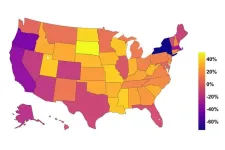(Press-News.org) The past decade has seen a significant increase in marijuana use among U.S. college students. This increase has coincided with notable changes in national and local cannabis laws and policies, and perceptions of the associated drug’s risk over the same period. However, cannabis use by students continues to be a public health challenge throughout the country. Universities have long relied on education programs to address these risks; however, many of these programs have limitations and fail to consider some of the modern risk factors for cannabis use among young adults.
A new study led by Benjamin Montemayor, PhD, assistant professor in the Department of Health Behavior at the Texas A&M University School of Public Health, looks into cannabis use patterns, motivations and risk factors for cannabis use among college students at a large public university in the southeastern United States. Results were published in the journal Cannabis.
Although many states have decriminalized or outright legalized cannabis, the drug remains illegal at the federal level and as such is largely banned on university campuses. Despite changes in perceived risks associated with cannabis use, using it can be problematic for college students, especially when used together with alcohol. For example, cannabis use is frequently associated with poorer academic performance and health outcomes such as substance use disorders, with upwards of 70 percent of college students who actively use marijuana meeting the criteria for a potential cannabis use disorder.
To further explore reasons and risk factors for cannabis use among college students, the researchers surveyed 99 students who had violated campus drug use policy. The survey asked students to report how many days of the past month they had used cannabis and how much cannabis (in grams) they typically used per day. The researchers also asked respondents to report their reasons for using cannabis, such as using it to relax or relieve tension, as a sleeping aid, as part of socializing with friends, to experiment or to escape from problems. The researchers finally asked respondents about various risk factors for cannabis use, such as how many students at their university they think also use cannabis, how their friends and families might view them decreasing their cannabis use, perceptions of risks associated with using cannabis regularly, concurrent alcohol co-use, and at what age they started using cannabis. The researchers examined the associations between the quantity of cannabis use per day and the various risk factors, controlling for demographic data such as sex, race and ethnicity, age, years in school and fraternity or sorority membership.
The researchers found that the top three reasons for cannabis use reported by students were to relax or relieve tension, to feel good or get high, and to have a good time with friends. The average age at which respondents reported they started using cannabis was 17 years. On average, students used cannabis on seven out of the past 30 days, with 8 percent reporting daily use of cannabis. The students used more than a quarter of a gram per day, on average, with 40 percent reporting having consumed at least one gram of cannabis per day on days they used. More than half of the sample of students also used alcohol in the past month.
The researchers found that students in the study believe nearly half (47 percent) of all other students on campus also use cannabis and believe their friends or family would think it’s a good idea for them to personally reduce their cannabis use. Finally, the researchers found a low perception of risk overall associated with cannabis use.
Analysis of the data found an association between cannabis use quantity per day and frequency, with students who reported higher quantity of cannabis use per day also reporting more days per month of cannabis use. The study also found a significant association between cannabis use and perceived risk, with more use per day associated with those who had the lowest perceived risk scores. Finally, race and ethnicity were reported to have a significant association with cannabis use, with students who identified as a racial or ethnic minority reporting greater cannabis use.
Modern cannabis interventions fail to address the complicated nature of cannabis in our society partly because of a lack of current information on the diverse ways students are experimenting with cannabis (for example, dabbing and gravity bongs) and the associated hazards. Cannabis has been around for centuries. To be effective, intervention programs should address the specific sociocultural contexts that impact cannabis use, such as culture, religion and values, and the way in which national and state policies conflict and potentially generate permissive norms that cannabis use is allowed on campus.
The findings of this study highlight the need for cannabis intervention programs that address psychosocial risk factors and motivations for cannabis use that are tailored to meet the needs of different racial, ethnic and cultural groups. Better understanding the motivations behind marijuana use and the various factors and perceptions associated with use in college students could help reduce risks presented by drug use.
“Policies are changing, and cannabis use at large is outpacing the rate at which research is coming out,” Montemayor said. “If we fail to adapt our programs to keep up with the way cannabis use has become an ingrained part of our society then we are failing to prioritize the health and safety of the student body.”
Montemayor also cited the Department of Health and Human Service’s recommendation to reclassify cannabis from a Schedule 1 drug, where it has been since the 1970s alongside heroin and crack, to a Schedule 3 drug as one reason why designing and implementing cannabis use programs on campus is as important an issue as it ever has been for universities around the nation.
END
Factors associated with marijuana use among high-risk college students
2023-10-05
ELSE PRESS RELEASES FROM THIS DATE:
Precise gene editing in human stem cells and neurons reveals links between genome organization and autism
2023-10-05
NEW YORK, NY (October 5, 2023) – Researchers have used CRISPR gene editing, stem cells and human neurons to study the impact of a gene that is commonly mutated in autism. This new study, published today in The American Journal of Human Genetics, ties mutations in the gene CHD8 with a broad spectrum of molecular and cellular defects in human cortical neurons.
Autism is a highly heritable disorder with a recent increase in incidence — approximately 1 in 40 children in the US are diagnosed with autism. Over the past decade, sequencing studies have found many ...
AI helps reduce online harassment by enhancing conversation courtesy
2023-10-05
Check the comments section of many social media and digital news platforms, and you’re likely to find a cesspool of insults, threats and even harassment. In fact, a Pew Research Center survey found that 41% of American adults have personally experienced online harassment, and one in five adults say they’ve been harassed online for their political views.
But researchers at BYU and Duke University say derisive online conversations don’t have to be the norm. A joint paper between the two universities found that artificial intelligence can be used to improve conversation quality and promote civil dialogue in online ...
Two-day course teaches hospitals and health systems how to address unprofessionalism and unsafe behavior
2023-10-05
With a myriad of external pressures and challenges facing hospitals and health systems today, it is more important now than ever to mitigate internal risks. Unprofessional behavior, which negatively impacts patient care, retention, and team dynamics, is a legal, financial, and cultural risk that many health systems are now looking to address head-on. Peer-reviewed research consistently shows unprofessional behavior in health systems can be reduced by 85% through implementing the right tools and processes.
The Vanderbilt ...
Study highlights use of TikTok to encourage cervical cancer screening
2023-10-05
TikTok and other short-form video platforms are booming in popularity — for entertainment and for sharing information, including health information.
Researchers are currently examining the effects of social media videos, and among them is Ciera Kirkpatrick, assistant professor of advertising and public relations at the University of Nebraska–Lincoln. Kirkpatrick, who studies the intersection of communication and health, recently turned her scientific eye toward TikTok.
In a newly published article, Kirkpatrick and co-author LaRissa Lawrie, a doctoral ...
K-pop fans helped COVID-19 public health messaging go viral
2023-10-05
Three years ago, as part of the public health messaging in response to the COVID-19 pandemic, the World Health Organization launched the "Wear A Mask" campaign on social media.
However, despite their benefits to public health, mask-wearing quickly became a highly politicized and divisive issue across the globe.
But the campaign gained impressive traction after World Health Organization Director-General Tedros Adhanom Ghebreyesus issued the following tweet on X, the social media platform known at the time as Twitter, on August 21, 2020, thanking BTS, a South Korean K-pop group, for supporting the mask-wearing public ...
Physicists find evidence for magnetically bound excitons
2023-10-05
In art, the negative space in a painting can be just as important as the painting itself. Something similar is true in insulating materials, where the empty spaces left behind by missing electrons play a crucial role in determining the material's properties. When a negatively charged electron is excited by light, it leaves behind a positive hole. Because the hole and the electron are oppositely charged, they are attracted to each other and form a bond. The resulting pair, which is short lived, is known as an exciton [pronounced exit-tawn].
Excitons are a key part of many technologies, including solar panels, photodetectors and sensors, as well as light-emitting ...
Dr. Julie Damp named ACC Annual Scientific Session Vice Chair
2023-10-05
The American College of Cardiology has announced Julie Damp, MD, FACC, as the next vice chair of the American College of Cardiology’s Annual Scientific Session. Damp will serve as vice chair for ACC.25 and ACC.26 and transition to chair for ACC.27 and ACC.28.
"ACC Annual Scientific Session is an incredibly impactful learning experience for cardiovascular care providers globally,” Damp said. “I am truly honored and excited to have the opportunity to work with the ACC team to provide effective and innovative education that impacts the care of our patients and expands the reach of cardiovascular science."
Damp is a professor of medicine in cardiovascular medicine ...
New research may make future design of nanotechnology safer with fewer side effects
2023-10-05
A new study may offer a strategy that mitigates negative side effects associated with intravenous injection of nanoparticles commonly used in medicine.
The study was published today in Nature Nanotechnology.
“Nanotechnology’s main advantage over conventional medical treatments is its ability to more precisely target tissues, such as cancer cells targeted by chemotherapy. However, when nanoparticles are injected, they can activate part of the immune system called complement,” said senior author Dmitri Simberg, Ph.D., professor of Nanomedicine and Nanosafety at the University of Colorado Skaggs School of Pharmacy ...
Climate intervention technologies may create winners and losers in world food supply
2023-10-05
A technology being studied to curb climate change – one that could be put in place in one or two decades if work on the technology began now – would affect food productivity in parts of planet Earth in dramatically different ways, benefiting some areas, and adversely affecting others, according to projections prepared by a Rutgers-led team of scientists.
Writing in the journal, Nature Food, the scientists described the results of computer models simulating varying climate scenarios and their impacts over time on the production of the world’s four major food crops: ...
Racial and ethnic disparities in glycemic control among insured adults
2023-10-05
About The Study: In this study of 4,070 insured adults with diabetes, disparities in poor glycemic control persisted despite adjustment for social, health care, and behavioral factors. Research is needed to identify the barriers contributing to poor control even in populations with access to care.
Authors: Sandra S. Albrecht, Ph.D., M.P.H., of the Columbia University Mailman School of Public Health in New York, is the corresponding author.
To access the embargoed study: Visit our For The Media website at this link https://media.jamanetwork.com/
(doi:10.1001/jamanetworkopen.2023.36307)
Editor’s Note: Please see the article ...



